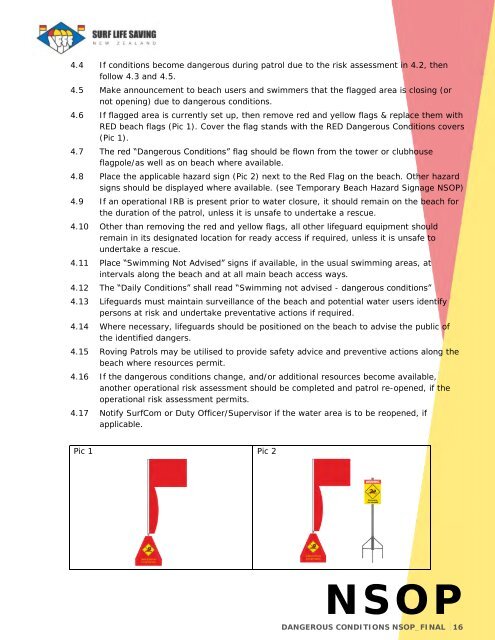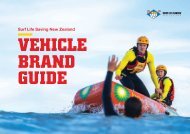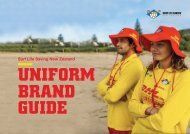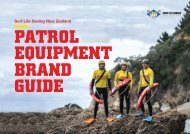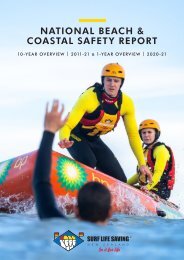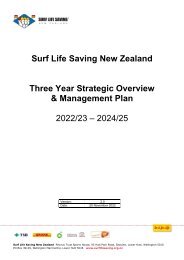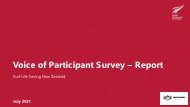National Standard Operating Procedures - Jul 2022
Full NSOP Manual
Full NSOP Manual
Create successful ePaper yourself
Turn your PDF publications into a flip-book with our unique Google optimized e-Paper software.
4.4 If conditions become dangerous during patrol due to the risk assessment in 4.2, then<br />
follow 4.3 and 4.5.<br />
4.5 Make announcement to beach users and swimmers that the flagged area is closing (or<br />
not opening) due to dangerous conditions.<br />
4.6 If flagged area is currently set up, then remove red and yellow flags & replace them with<br />
RED beach flags (Pic 1). Cover the flag stands with the RED Dangerous Conditions covers<br />
(Pic 1).<br />
4.7 The red “Dangerous Conditions” flag should be flown from the tower or clubhouse<br />
flagpole/as well as on beach where available.<br />
4.8 Place the applicable hazard sign (Pic 2) next to the Red Flag on the beach. Other hazard<br />
signs should be displayed where available. (see Temporary Beach Hazard Signage NSOP)<br />
4.9 If an operational IRB is present prior to water closure, it should remain on the beach for<br />
the duration of the patrol, unless it is unsafe to undertake a rescue.<br />
4.10 Other than removing the red and yellow flags, all other lifeguard equipment should<br />
remain in its designated location for ready access if required, unless it is unsafe to<br />
undertake a rescue.<br />
4.11 Place “Swimming Not Advised” signs if available, in the usual swimming areas, at<br />
intervals along the beach and at all main beach access ways.<br />
4.12 The “Daily Conditions” shall read “Swimming not advised - dangerous conditions”<br />
4.13 Lifeguards must maintain surveillance of the beach and potential water users identify<br />
persons at risk and undertake preventative actions if required.<br />
4.14 Where necessary, lifeguards should be positioned on the beach to advise the public of<br />
the identified dangers.<br />
4.15 Roving Patrols may be utilised to provide safety advice and preventive actions along the<br />
beach where resources permit.<br />
4.16 If the dangerous conditions change, and/or additional resources become available,<br />
another operational risk assessment should be completed and patrol re-opened, if the<br />
operational risk assessment permits.<br />
4.17 Notify SurfCom or Duty Officer/Supervisor if the water area is to be reopened, if<br />
applicable.<br />
Pic 1 Pic 2<br />
NSOP<br />
DANGEROUS CONDITIONS NSOP_FINAL 16


